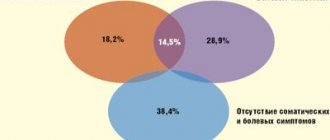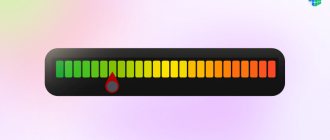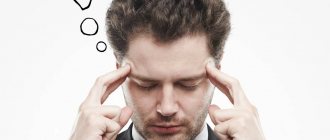Mechanism of action and pharmacokinetics
Mirtazapine has a tetracyclic structure and is classified as a noradrenergic and specific serotonergic antidepressant (NSSA). Acting as an antagonist of “inhibitory” central presynaptic α-2 autoreceptors, interfering with negative feedback and causing the release of norepinephrine. Blockade of heteroreceptors, α-2 receptors contained in serotonin neurons, enhances the release of serotonin, increasing the interaction between serotonin and 5-HT1 receptors and thereby promoting the anxiolytic effect of mirtazapine. Mirtazapine also acts as a weak antagonist of 5-HT1 receptors and as a strong antagonist of 5-HT2 (especially subtypes 2A and 2C) and 5-HT3 receptors. Blockade of these receptors may explain the lower incidence of side effects such as anxiety, insomnia and nausea, which are common with SSRI antidepressants. Mirtazapine also exhibits significant antagonism at histamine H1 receptors, resulting in sedation. Mirtazapine does not affect the reuptake of norepinephrine and serotonin, and also has minimal activity at dopaminergic and muscarinic receptors.
- Bioavailability about 50%
- Equilibrium concentration in the blood is established after 3–4 days
- Half-life 20-40 hours
- Actively metabolized in the liver by demethylation and oxidation followed by conjugation
- Metabolized by cytochromes P450 2D6, P450 1A2 and P450 3A4.
- Eating does not affect absorption
Clinical features of the use of mirtazapine (Mirtazonal)
Currently, antidepressants of various pharmacological groups are presented on the domestic market. A number of them are widely used in clinical practice and are well known to both psychiatrists and general practitioners. This primarily applies to selective serotonin reuptake inhibitors (SSRIs). Other drugs are less known, despite the data available in the literature and the extensive experience of their use by foreign colleagues for various mental disorders. One of these antidepressants is mirtazapine (Mirtazonal).
In terms of its chemical structure, it is close to mianserin (6-azamianserin), the drug weakly blocks the reuptake of norepinephrine, is an antagonist of presynaptic and postsynaptic alpha-2 adrenergic receptors and postsynaptic C-2 and C-3 serotonin receptors and, therefore, selectively potentiates the effects of serotonin on C-1-serotonin receptors (38). Thus, the drug has a mixed norepinephrine- and serotonin-positive effect and is practically devoid of adrenolytic and cholinolytic properties, but has a moderate antihistamine effect. Blockade of serotonin receptors type 2A and 2C promotes the release of dopamine and norepinephrine in the brain. Thus, mirtazapine is a “triple action” antidepressant that replenishes the deficiency of serotonin, norepinephrine, and dopamine (3). Unlike mianserin, the drug has little effect on alpha-1-adrenergic receptors and does not have a peripheral serotoninolytic effect.
Mirtazapine is rapidly absorbed from the gastrointestinal tract, its bioavailability is about 50%. Peak concentrations in the blood are reached 2 hours after taking the tablets. Equilibrium concentration is established within 3-5 days. 85% of the drug binds to blood plasma proteins. Demethylmirtazapine is also pharmacologically active as the parent substance. P-450 isoenzymes do not appear to be involved in drug metabolism, thereby avoiding numerous interactions. The plasma half-life is 20-40 hours. The complete dose is excreted in approximately 4 days, 85% in urine and 15% in feces. About 4% of the drug can be excreted unchanged in the urine.
The spectrum of psychotropic activity of mirtazapine is determined by its thymoanaleptic effect with a sedative component, especially pronounced at the beginning of therapy. In the clinic, the drug showed distinct anxiolytic and hypnotic properties, as well as moderate, time-delayed activating properties, which makes it possible to classify it as a balanced antidepressant with a slight predominance of the sedative component. Several placebo-controlled studies have been conducted on the effectiveness of mirtazapine in depression compared with tricyclic antidepressants. In all studies, mirtazapine was superior to placebo and demonstrated similar efficacy to amitriptyline in severe depression with significantly better tolerability (22, 30, 39, 47). Moreover, both drugs acted predominantly on depressed mood and other symptoms associated with depression, such as anxiety, sleep, and autonomic dysfunction. When comparing mirtazapine with imipramine, it turned out that with the same overall effectiveness in the treatment of severe depression, Mirtazapine was more effective than imipramine in relation to such depressive clusters as “sleep” and “anxiety/agitation,” which made it possible to avoid concomitant anxiolytic and hypnotic therapy when taking mirtazapine (16 ). Comparative studies of the effectiveness of mirtazapine in depression with some of the SSRIs (Citalopram, Sertraline, Paroxetine, Fluoxetine) showed that mirtazapine was superior to all of these drugs in the rate of onset of effect (10, 11, 44, 46), and in patients with concomitant insomnia only mirtazapine improved objective sleep parameters (6, 9, 46). Mirtazapine has been shown to be effective in the treatment of depression with somatic symptoms (20). When asthenic-anergic symptoms dominate in the clinical picture of depression, monotherapy with mirtazapine turned out to be less effective (4).
Although mirtazapine is not a hypnotic, in cases of insomnia with concomitant depressive symptoms or in patients with a history of depressive symptoms, it is appropriate to prescribe it in low doses, where it shortens the period of sleep onset and increases its duration (41, 45). For patients with underlying cardiovascular disease, the ability of mirtazapine to control early awakenings is especially important, since it is during these hours that cardiovascular events most often occur (8).
Particular attention should be paid to studies on the use of mirtazapine when other antidepressants are ineffective. Similar data have been obtained for TCAs and SSRIs. The effectiveness of mirtazapine when previous TCA therapy is ineffective is 50-60%. Moreover, already in the second week of treatment, patients experience a clear reduction in ideational and motor retardation, which exceeds these indicators in non-resistant patients (7). In SSRI-resistant depressed patients, switching to mirtazapine led to significant improvement in 40-50% of cases (19, 43), and it was shown that there was no need for a washout period. Another way to overcome treatment resistance in depressive conditions is to take two antidepressants together. Placebo-controlled studies have shown that the addition of mirtazapine to amitriptyline minimally changes the pharmacokinetics of both drugs, with remission rates reaching 45% after 4 weeks of coadministration (17, 36). Similar remission rates were obtained when taking paroxetine and mirtazapine (48%), fluoxetine and mirtazapine (52%), and venlafaxine and mirtazapine (58%) together (13, 33).
Good results were obtained with the prophylactic use of mirtazapine in patients with recurrent depression (26, 29). Relapses of depressive symptoms when taking mirtazapine within a year are observed in no more than 10% of patients, while mirtazapine plays a lesser role in the initial period of anti-relapse therapy (26, 29).
Due to its good tolerability spectrum, mirtazapine has been used in recent years in the treatment of depression in somatic and neurological diseases. In cases of comorbid major depressive disorder and temporal lobe epilepsy, mirtazapine significantly alleviated depressive symptoms by the end of the first month of therapy, without leading to an increase in seizures and a change in the dose of the main anticonvulsants in the blood (24, 37). One multicenter study showed that treatment of post-infarction depression with mirtazapine can not only reduce depressive symptoms, but also significantly improve the prognosis and quality of life in these patients (15). In another study, mirtazapine was added to basic therapy in cancer patients with persistent pain: mirtazapine improved the quality of life of these patients and alleviated pain (40). Data have been obtained regarding the effectiveness of mirtazapine in other pain syndromes. Mirtazapine, along with amitriptyline, is recognized as the first choice drug for the treatment of chronic tension-type headaches (9, 27). The success of antidepressants is associated with increased activity of the antinociceptive system, the inhibition of which occurs in pain syndromes. In addition, mirtazapine may reduce the frequency of migraine attacks and reduce chronic dorsalgia (9).
It is known that significant signs of depressive conditions in elderly and senile people are the severity of anxiety disorders and cognitive dysfunction. Several studies have reported that mirtazapine results in resolution of difficulty falling asleep, restoration of nighttime sleep duration and depth, and reduction in tearfulness within 1–2 weeks of treatment, with response rates reaching 60–70% by the end of 4 weeks of treatment (95). Placebo-controlled studies using paroxetine as a comparator showed an advantage of mirtazapine in a number of indicators, primarily in the degree of anxiety reduction (34, 35). The use of mirtazapine is not associated with a decrease in cognitive abilities in elderly patients. Moreover, the drug has a positive effect on integrative psychophysiological parameters of attention and improves the volume of working memory (1, 5).
Mirtazapine has also proven itself well as a means of relieving depressive disorders in the structure of alcohol withdrawal syndrome. Mirtazapine led to normalization of sleep, had a vegetostabilizing and somatotropic effect, and also created favorable conditions for psychotherapy (2, 25). Mirtazapine can also be recommended for the relief of subdepressive disorders during long-term anti-relapse therapy during remission in patients with alcoholism (2). Its high effectiveness and good tolerability have been shown for sleep disorders in the structure of methamphetamine withdrawal syndrome (28).
There are isolated indications of the possibility of using mirtazapine in anxiety-phobic conditions, in particular panic disorder. Mirtazapine results in a reduction in the frequency of panic attacks starting at week 2 of treatment, with a maximum effect at week 8 (14). In one study, mirtazapine was as effective as fluoxetine in the treatment of panic disorder (32). However, it should be recognized that mirtazapine has not been sufficiently studied for the treatment of obsessive-phobic disorders.
Data were obtained on the ability of mirtazapine to significantly reduce negative symptoms in patients with schizophrenia treated with haloperidol. The anti-deficiency activity of mirtazapine was not derived from mood improvement (12). Low-dose mirtazapine can be recommended as a treatment for neuroleptic akathisia (31).
Mirtazapine is used in average doses of 15-45 mg/day. The initial dose is 15 mg/day, after 4 days it is increased to 30 mg/day, after 10 days, if there is no effect, it can be increased to 45 mg/day. In severe cases, the dose can be increased to 60-80 mg/day. A sufficiently long half-life allows the drug to be prescribed once a day, usually at night. The effect develops gradually, usually in the 2-3rd week of therapy, but treatment with the drug should be continued for another 4-6 months.
Compared with tricyclic antidepressants, the drug is well tolerated and therefore can be used in elderly patients. Among the side effects, the most common are transient daytime drowsiness (disappears during the first week of treatment as you adapt to the drug or after reducing the dose), dryness of the mucous membranes of the oral cavity, as well as an increase in appetite and body weight. Symptoms such as sweating, headache, tachycardia, and nausea are much less common. Moreover, the greatest number of undesirable effects occurs in the first 2 weeks of therapy, with a significant decrease in them by 3-4 weeks of treatment.
Contraindications to treatment with the drug are renal and liver failure. It is not recommended to use mirtazapine in combination with MAO inhibitors or during pregnancy.
Despite the wide range of psychotropic activity, in the practice of domestic psychiatry, mirtazapine is used quite rarely, which is primarily due to the cost of the original drug mirtazapine, Remeron, being one of the highest among all antidepressants (3). Recently, a much more affordable generic has appeared on the Russian market - Mirtazonal, produced by the famous Icelandic company Actavis. Mirtazonal is produced in accordance with the European GMP quality standard; safe excipients are used in its production.
Data are available on the bioequivalence of Mirtazonal and Remeron.
Thus, it is obvious that with the advent of a high-quality generic Mirtazonal in Russia, which is in no way inferior to the original drug, but much more affordable, the “triple-action” antidepressant Mirtazapine, unique in its spectrum of psychotropic activity, will become more widely used in general psychiatric and drug treatment practice.
Treatment regimen
◊ Dosage and dose selection
- For depression: 15-45 mg/day
- Initial dose – 15 mg in the evening; increase every 1-2 weeks until the effect is achieved; maximum – 45 mg/day
- Sedation will not increase with increasing dose
- Crushing the 15 mg tablet into two halves will increase sedation [1].
- For hot flashes: 7.5 mg-60 mg
- Insomnia/PTSD: 15-45 mg
- If anxiety, insomnia, agitation, or akathisia occur at the beginning of treatment or after interruption of treatment, the possibility of bipolar disorder should be considered and switched to a mood stabilizer or an atypical antipsychotic
◊ How quickly it works
- In patients with insomnia and anxiety, it may take immediate effect.
- Begins to act after 2-4 weeks
- If there is no effect after 6-8 weeks, you need to increase the dose or switch to another drug
- To prevent relapse, it can be taken for many years.
◊ Expected result
- Complete remission.
- After the symptoms of depression disappear, you should continue taking it for one year if this was the treatment of the first episode. If this is to treat a recurrent episode, treatment can be extended indefinitely.
- Use in the treatment of anxiety may be indefinite.
◊ If it doesn't work
- Change the dose, switch to another medicine or add an auxiliary drug;
- Connect psychotherapy;
- Review the diagnosis by identifying comorbid conditions;
- In patients with undiagnosed bipolar affective disorder, the effectiveness of treatment may be low, in which case it is necessary to switch to a mood stabilizer [1].
◊ How to stop taking it
It can be reduced gradually, but there is no need [1].
◊ Treatment combinations
- For fatigue, drowsiness, loss of concentration: modafinil [3].
- Use combinations with other antidepressants with caution because they may precipitate bipolar disorder and suicidal ideation.
- Combination with venlafaxine (“California Rocket Fuel”) is a strong combination, but watch for risk of bipolar disorder and suicidal ideation [1]
- Benzodiazepines
- For bipolar depression, psychotic depression, treatment-resistant depression, treatment-resistant anxiety disorder: mood stabilizers, atypical antipsychotics
- For anxiety disorder: gabapentin, tiagabine
Special patient groups
◊ Patients with kidney problems
With caution [1].
◊ Patients with liver disease
- Carefully;
- Lower doses are recommended [1].
◊ Patients with heart disease
- Carefully;
- Consider the risk of low blood pressure [1].
◊ Elderly patients
For some patients, it is better to stay at low doses [1].
◊ Children and teenagers
- Safety and benefit have not been proven
- It is necessary to regularly and personally check the patient's condition, especially in the first weeks of treatment.
- Inform adults about the risks.
◊ Pregnant women
- There have been no adequate studies in pregnant women [1].
- Not recommended for pregnant women, especially in the first trimester
- All risks should be weighed and compared
◊ Breastfeeding
- The medicine passes into breast milk.
- If the infant shows signs of irritation or sedation, stop feeding or taking mianserin
- However, treatment after childbirth may be necessary, so the risks should be weighed.
Side effects and other risks
◊ Mechanism of side effects
Most side effects occur immediately after starting treatment and go away over time, while the therapeutic effects increase over time. The action on the histamine receptor explains the sedation.
◊ Side effects
- Dry mouth, constipation, increased appetite
- Sedation, unusual dreams
- Low pressure
- Dangerous side effects: seizures, blood dyscrasia, mania
- Weight gain: very common
- Sedation: very common (worsens over time)
- Sexual dysfunction: no
◊ What to do about side effects
- Wait;
- Change drug [1].
◊ Long-term use
Safely
◊Addiction
Not expected.
◊ Overdose
- Rare cases of fatal overdoses have been associated with the use of mirtazapine along with other substances
- Sedation, disorientation, memory impairment.
results
- At week 12, Beck score was 18.0 (12.3) in the mirtazapine group and 19.7 (12.4) in the placebo group (adjusted mean difference, −1.83 (95% CI −3.92 to 0.27). ); P=0.09).
- At weeks 24 and 52, there were also no significant differences in depressive symptoms between the study groups (difference, −0.85 (95% CI −3.12 -1.43) at week 24 and 0.17 (95% CI −2 .13-2.46) at 52 weeks).
- Side effects were more common in the mirtazapine group. It was noteworthy that 46 patients from the main group stopped treatment due to adverse events, while only 9 in the placebo group.











